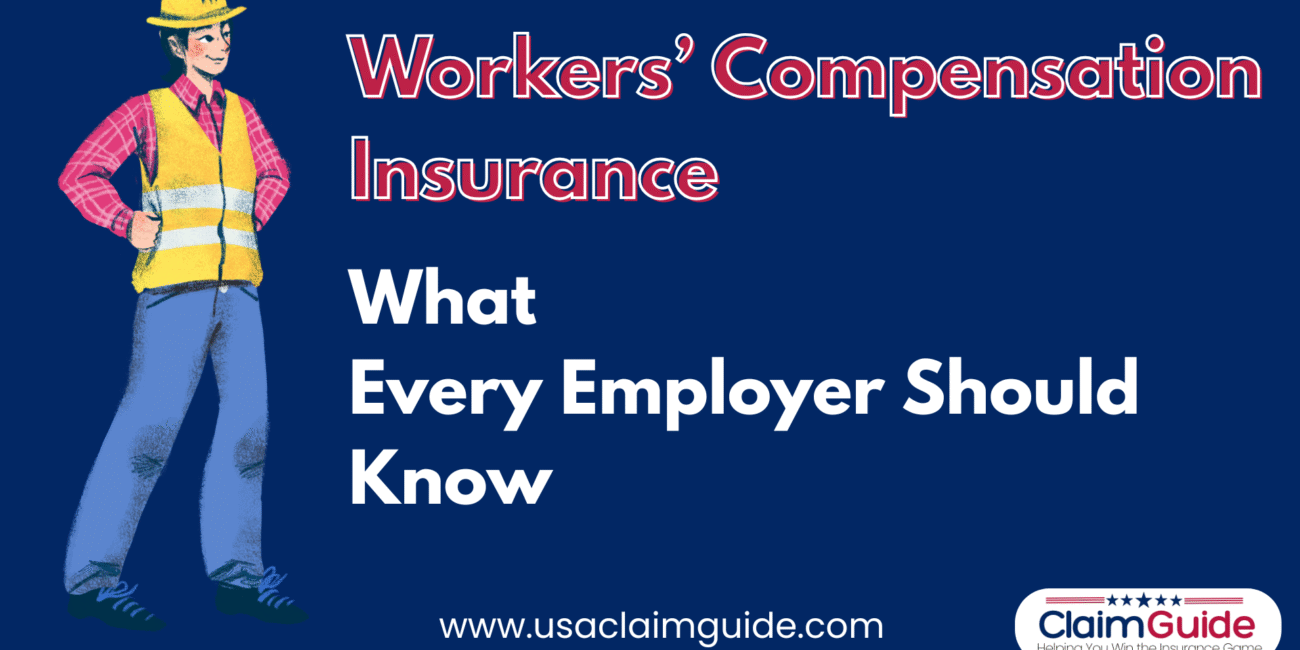Running a business in the United States today means juggling dozens of responsibilities compliance, payroll, safety, staffing and none are more crucial than ensuring your employees are protected if the unexpected happens. That’s where workers’ compensation insurance in the U.S. comes into play. For both new and established employers, understanding the ins and outs of this mandatory coverage is vital for legal compliance and workforce protection.
Whether you’re seeking affordable workers’ compensation insurance for small businesses in the U.S. or looking to upgrade an outdated policy, knowing what’s required and how the system works can save you thousands in potential fines and lawsuits. Beyond cost, it’s about fulfilling your duty to those who keep your business running your employees.
Workplace accidents can happen anywhere from a construction site to a corporate office. That’s why more business owners are proactively searching for how to protect employees from workplace injuries through comprehensive coverage. Workers’ compensation not only pays for medical care and lost wages it also reassures your team that you’re committed to their safety and financial well-being.
Every state in the U.S. has its own rules, making it essential to research the legal requirements for workers’ comp in the U.S. based on where your business operates. Failing to carry the correct policy can lead to steep penalties, business license suspension, or even lawsuits. That’s why understanding your employer responsibilities under workers’ compensation law isn’t just smart it’s non-negotiable.
This guide is designed to help business owners, HR professionals, and sole proprietors navigate the landscape of understanding workers’ comp insurance policies in the United States. We’ll break down what you need to know without the legal jargon so you can make confident decisions that protect your people and your bottom line.
Workers’ Compensation Insurance : Complete Guide for Employers and Workers
Workers’ compensation insurance in the U.S. plays a crucial role in protecting both businesses and employees from the financial fallout of workplace injuries. Whether you’re an employer looking to stay compliant or a worker trying to understand your rights, this guide provides a complete overview from definitions and coverage to costs, claims, and official resources.
What is Workers’ Compensation Insurance?
Workers’ compensation insurance is a type of policy that provides financial and medical benefits to employees who are injured or become ill due to job-related activities. It is mandated in most U.S. states and helps cover medical expenses, rehabilitation costs, and a portion of lost wages.
This insurance not only supports injured employees but also shields employers from costly lawsuits, as employees who receive benefits typically waive the right to sue their employers for negligence.
At its core, workers’ compensation insurance is a state-mandated system designed to provide financial protection and medical support for employees who suffer job-related injuries or illnesses. It serves as a contract between employers and employees: in exchange for certain benefits, the worker generally gives up the right to sue the employer for negligence. This structure helps to prevent legal battles while ensuring injured workers receive timely care and compensation.
But workers’ compensation is more than just a safety net it’s a critical piece of risk management. By carrying an active policy, employers reduce the financial burden of workplace accidents and demonstrate compliance with labor laws. For employees, this coverage offers assurance that if they’re hurt on the job whether it’s a slip-and-fall accident, machinery-related injury, or even long-term exposure to harmful substances they won’t have to bear the cost of recovery alone.
Many business owners are surprised to learn that workers’ compensation insurance in the U.S. isn’t a one-size-fits-all policy. It must be tailored to industry risk levels, workforce size, and state-specific legal requirements. That’s why understanding what this insurance entails is the first step in creating a safe and legally compliant workplace.
From covering emergency medical treatment to compensating for lost income during recovery, workers’ comp provides the structure businesses need to operate responsibly and the peace of mind employees deserve. It’s not just a policy it’s a promise of protection.
Workers’ Compensation Definition
At its core, workers’ compensation refers to a system of laws and insurance that provides wage replacement and medical benefits to employees injured on the job. The system operates under a “no-fault” principle, meaning employees can receive compensation regardless of who was at fault for the injury.
In the U.S., each state administers its own workers’ compensation program, often through a dedicated agency or workers’ compensation board.
Why Workers’ Compensation Insurance is Important
There are several key reasons why workers’ compensation insurance in the U.S. is critical for businesses and employees:
- Legal Compliance: Most states legally require businesses with employees to carry workers’ compensation insurance.
- Financial Protection for Workers: Injured employees receive coverage for medical treatment and wage loss, helping them recover without financial stress.
- Lawsuit Prevention: It minimizes the risk of employers being sued for workplace injuries.
- Workplace Morale: Employees feel more secure knowing their employer prioritizes their health and well-being.
- Business Continuity: Prevents business interruption due to lengthy legal battles or out-of-pocket injury claims.
Also Read: Business Interruption Insurance: Covers, Payout, Claim and more
Workers’ Compensation Insurance: What Does It Cover?
Here’s a breakdown of what workers’ compensation insurance in the U.S. typically covers:
- Medical Expenses
- Hospital visits
- Surgery
- Medications
- Rehabilitation and therapy
- Lost Wages
- Temporary disability benefits
- Permanent disability benefits
- Vocational Rehabilitation
- Job retraining
- Placement services if the worker cannot return to their previous job
- Death Benefits
- Funeral expenses
- Financial support to dependents
- Ongoing Care
- Long-term medical treatment for chronic conditions caused by workplace accidents

What Are the Types of Workers’ Compensation Insurance?
Workers’ compensation insurance can be categorized based on how it is structured and managed:
1. Private Insurance
Most employers buy policies from private insurers licensed to provide workers’ compensation coverage in a given state.
2. State-Funded Programs
Some states offer state-run insurance funds, such as:
- California’s State Compensation Insurance Fund (SCIF)
- Ohio’s Bureau of Workers’ Compensation (BWC)
3. Self-Insurance
Larger businesses with robust financial backing can opt to self-insure. They must meet strict state criteria and prove they can handle claims internally.
4. Monopolistic State Funds
States like North Dakota, Ohio, Washington, and Wyoming require businesses to purchase coverage exclusively through state-run programs.
What Doesn’t Workers’ Compensation Pay For?
While the coverage is extensive, there are some exclusions:
- Injuries outside of work
- Self-inflicted injuries
- Injuries caused by substance abuse or intoxication
- Mental health issues unrelated to job duties
- Violations of company policy or illegal activities
- Independent contractors (in most states, unless specifically covered)
Do I Need Workers’ Compensation Insurance?
For Employers:
If you have employees—whether full-time, part-time, or seasonal you likely need workers’ compensation insurance in the U.S. Most states require it even if you employ just one person.
For Self-Employed or Independent Contractors:
While not required, it’s often recommended for independent contractors in high-risk industries like construction or transportation.
For Out-of-State Operations:
You may need separate policies for each state in which you operate, based on local laws.
Also Read: Commercial Property Insurance : What It Covers, How It Works, & Why Your Business Needs It
How to Get Workers’ Compensation Insurance
Follow these steps to secure the right policy for your business:
Step 1: Check State Requirements
Every state has unique laws. Start with your state’s department of insurance or labor.
Step 2: Compare Providers
Get quotes from:
- Private insurance companies
- State-funded programs (if applicable)
- Licensed insurance brokers
Step 3: Evaluate Coverage Options
Ensure your policy meets legal requirements and adequately covers your risk level.
Step 4: Apply and Purchase
Provide details such as:
- Number of employees
- Type of work
- Payroll estimates
- Safety measures in place
Step 5: Stay Compliant
Maintain up-to-date records, renew coverage on time, and conduct regular risk assessments.
How Much Does Workers’ Compensation Insurance Cost?
Costs vary widely, influenced by factors such as:
- Industry Risk: Construction pays more than clerical services.
- Payroll Size: Premiums are calculated per $100 of payroll.
- Claims History: Businesses with prior claims often pay higher rates.
- State Regulations: Rates are determined or influenced by state agencies.
Average Cost:
Most U.S. businesses pay between $0.75 and $2.50 per $100 of payroll.
Who Pays Workers’ Compensation Insurance Premiums?
Employers are solely responsible for paying premiums. It is illegal in most states to deduct the cost of workers’ comp insurance from an employee’s paycheck.
How to Claim Workers’ Compensation Insurance: Step-by-Step Guide
Here’s a simplified but comprehensive roadmap for filing a claim:
For Employees:
- Report the Injury
- Notify your supervisor immediately. Most states require you to report within 30 days.
- Seek Medical Treatment
- Use an approved provider if required by your employer’s insurance policy.
- Complete Claim Form
- Fill out the required state-specific form (often called Form C-1, WC-1, etc.).
- Submit Documentation
- Provide medical records and proof of injury.
- Follow Up
- Cooperate with any ongoing evaluations or treatment plans.
For Employers:
- Provide Claim Forms
- Give the injured employee the necessary paperwork.
- File the Claim with Insurer
- Send completed forms to your insurance provider.
- Work with the Claims Adjuster
- Offer additional info as needed.
- Support Return-to-Work Programs
- Facilitate a smooth recovery and reintegration process.
Also Read: Liability Insurance : What It Covers, Why You Need It, & How Much It Really Costs
Official Resources and Government Links
Here are reliable U.S. government resources related to workers’ compensation insurance:
- U.S. Department of Labor – OWCP
- National Institute for Occupational Safety and Health (NIOSH)
- State Workers’ Compensation Boards
- Small Business Administration (SBA) Guide on Insurance
Additional Tips and Information
- Safety First: Preventing workplace injuries through training and safety measures can reduce premiums.
- Annual Audits: Your insurance provider may audit your business to ensure accurate payroll reporting.
- Experience Modification Rate (EMR): A numerical representation of your claims history. A lower EMR = lower premiums.
Conclusion
Understanding workers’ compensation insurance in the U.S. is vital for employers aiming to stay compliant and for employees seeking security in the workplace. With the right insurance in place, both parties benefit from reduced risk and faster recovery when workplace injuries occur.
Whether you’re just starting your business or reassessing your current policy, take the time to review state laws, compare plans, and prioritize a safe work environment.











